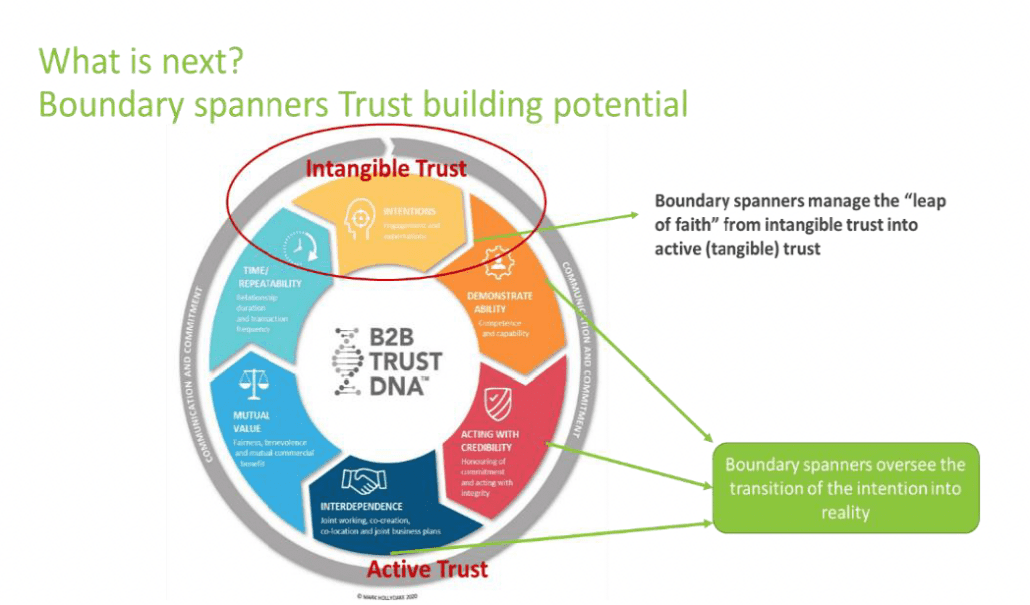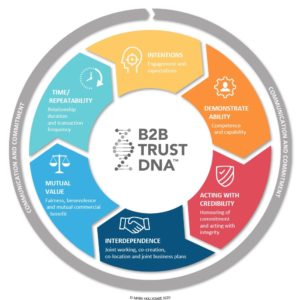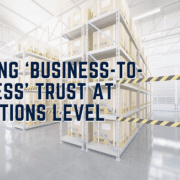B2B Trust Research: What are Boundary Spanners?
B2B Trust Research: What are Boundary Spanners?
Dr Mark Hollyoake addresses how boundary spanners occur and what they do to B2B Trust in his latest research
The focus of my next research stage builds on the insights generated through the doctoral thesis, digging deeper to explore the role of the boundary spanner in relational trust development.
Boundary spanners: What are they? What do they do? Why are they important? ![]()
On a very simple level they are actors on both sides of a relationship that span the boundary between one and another for relational management and/or development. According to Mollering (2002), boundary spanners manage the ‘leap of faith’, responsible for managing and mitigating risk, as is evident in Figure 1.

Figure 1: Boundary Spanner role: transition from intention into reality.
In reality the boundary spanner role is not simply a set of rules that are followed to the letter, (Perrone, V. Zaheer, A. McEvily 2003). The role is often open to interpretation and frequently subject to multiple, complex 2 and conflicting pressures (Kahn at al 1964). Therefore, we cannot predict the development of trust merely based on the formal role definition, and must look beyond this to understand the subtleties of how roles influence the level of trust that is placed upon them.
In their research into boundary spanners Neal, J.W., Neal, Z., and Brutzman, B., (2022) uncovered a number of definitions related to role of boundary spanner, ‘… we define the practice of boundary spanning as work to enable the exchange between the production and use of knowledge to support evidence-informed decision-making in a specific context and boundary spanners as individuals or organisations that specifically and actively facilitate this process.’
Bednarek et al, define boundary spanning as: ‘work to enable exchange between the production and use of knowledge to support evidence-informed decision making in a specific context’, while Posner and Cvitanovic2 define boundary spanners as the ‘individuals or organisations that specifically and actively facilitate this process.’
And here lies the paradox. While the theory seems straightforward, the application is quite different.
The work I initially covered in my doctoral thesis focussed on B2B relational trust, offering significant insights into the dynamic nature of trust, how it operates, the impact it has on B2B relationships, and how to proactively develop it in B2B, and from this research I developed a B2B trust DNA™ Model (Figure 2).

Figure 2: Trust DNA™ Model
The model developed from this research provides a systemic approach to trust building, starting at the intention stage which is intangible trust. It then moves into active trust through the reality of ability, credibility and the interdependence within the relationship. If applied pro-actively and positively by both sides it results in the development of mutual value. Relational commitment and communication act as the oil to the central DNA, enabling them to work effectively in the pursuit of mutual value creation.
However, from projects with various organisations over the last 15 years, it’s become increasingly clear that more research is needed in to the role of boundary spanners in Figure 2: Trust DNA™ Model 3, developing relational trust as they navigate the relationship from intangible trust into tangible trust, (as can be seen in Fig 1.)
What will additional research do for B2B Trust?

The diagram above illustrates the areas within B2B that the literature review addresses.
To date, there has been significant research into the way boundary spanners work, but much of the literature revolves around role diversity, role stress, inter-role behaviour, role stress theory and role behaviour.
The diagram here illustrates the areas within B2B that the literature review addresses:
The literature also demonstrates how boundary spanners without role clarity can create ambiguity that leads to role stress and early burnout. The boundary spanner can be torn between the needs of their own organisation and the needs/business drivers of the customer, as due to their unique location in the organisation spanning both sides, they are simultaneously exposed to competing expectations from their own and also from the partner organisation (Khan at al 1964, Strauss 1962, Spekman 1979).
It is not unusual to encounter boundary spanners working tactically outside of the required role, despite having clear descriptors developed through a capability and competency framework. The strategic element of the role gets lost among daily firefighting short-term tactical issues. This can be seen when boundary spanners experience role ambiguity on a personal level, internal organisational and external level. The pursuit of undertaking the responsibility for firefighting and resolution of short-term issues and challenges in the business and relationship could be viewed as:
- Justification and role protection – need to be seen to be active within the relationship.
- Covering shortfalls in operations and the organisation’s customer – centric culture.
- Lack of clarity and understanding of what the role encompasses.
- Insufficient role training and development.
- Profile building internally/externally.
Any of these can lead to relational downsides and turbulence as the short-term focus comes at a cost, and reduces relationship management and development. Unless addressed, over time the relationship descends into short-termism, with an erosion of the overall relational intent.
What the research says on Boundary Spanners:
The literature addresses some aspects related to the role that boundary spanners undertake in managing the migration of the relationship as it moves from intangible to tangible and its ongoing trust development. When we consider the ways that trust develops and how this potentially links to the Trust DNA™ model (contained in figure 2) several themes start to emerge:
- The activities boundary spanners undertake to mitigate the relationship and/or perceived risk in moving from intangible to tangible trust, and those involved in making it happen.
- The elements of the boundary spanner roles (customer & supplier) that are undertaken to develop a trust-based relationship.
- The translation of the relational intent into implementation plans that are briefed, socialised, and agreed by both sides.
- Value opportunity broken out into elements of initial value across the (CHARM) value model, and how value will be realised with an appropriate measurement framework.
- Sharing learnings, knowledge to build ability within the relationship.
- Leading cross functional joint working, setting the objectives, ways of working and measurement framework.
- Developing and implementing communication plans; the who, the how often, medium used, style and messaging; the provision of one voice for the relationship across all levels, functions and both sides.
- Demonstrating relational commitment, monitoring relationship commitment, and creating relationship commitment.
- Agreeing the relationship performance dashboard, monitoring, and sharing relationship development versus plan, re-calibrating where necessary.
Is there a Boundary Spanner in your office?
All the above, offer significant opportunity to understand the intricacies of the boundary spanner role and how it could be deployed for relationship improvement and trust building. Understanding this can inform capability and competency development, role specifications and development programme for those already in role or in early career stage development.
The research I propose represents the next stage exploring relationship trust building. If you would like to know more, get actively involved as the research enters the field stage, and from the insights it generates, get in touch with me here.
For more information on my original research in developing the Trust DNA Model.
References
- Bednarek, 2018: 1176.
- Posner and Cvitanovic, 2019: 141–142.
- Identification Based Trust - October 21, 2024
- Introducing Knowledge Based Trust - October 15, 2024
- Introduction to Risk-Based Trust - October 8, 2024





